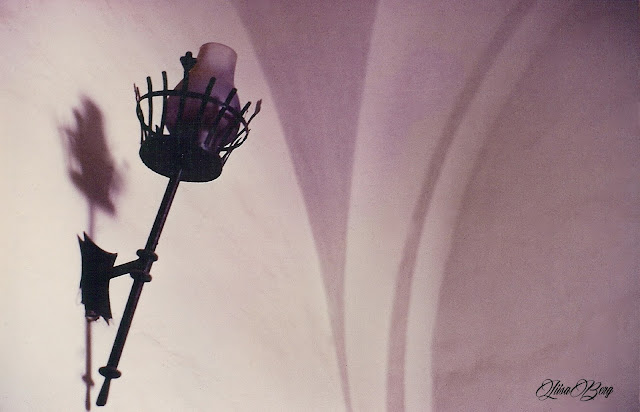When you go to an awesome place, you can always get awesome pictures. Something new, different, amazing...
When I was doing photography on the road, my mantra was "See it differently." Instead of documenting a place with the usual panoramas and "I was here" pictures, let's see details, let's see things from surprising angles, let's see boldness and daring in travel photography! And lucky for me, publishers seemed to like the idea...
Presented here in no particular order.
‡ One of my personal favorites, a surprise as it was developed: an armored statue at the Alcázar ("Sleeping Beauty's Castle") in Segovia. I had no idea how it would turn out, taken against the light, but sometimes luck is on my side even if the light is "against" me...
‡ Suprising delicate play of light and shadow in the rugged stone fort, the same as above. I especially enjoy the two candelabras; their delicacy is a comfortable contrast to the massive stone-and-brick walls and arches.
‡ Fine-art pottery in the museum at Topkapi, Istanbul. I was stunned to see the half-reveal of this magnificent piece.
‡ Surprise play with light and shadow in the Musmak Palace in Riyadh, Saudi Arabia.
‡ Quick trip to Jerusalem, to the Grand Mosque, its gleaming cupola here being framed by the slender columns of the mosque itself.
‡ A rare photo of a Saudi woman with her mask and abaya. She was married to an American and lived on our compound. She was fairly well westernized but also followed the traditional customs of her homeland.
‡ Sunset on the Red Sea, Jeddah, by the large monuments on the Corniche. Human form is sacred in Islam, it cannot be imitated in art in any way, so the monuments of other topics are plentiful and often whimsical, such as a huge bicycle. This is part of one that had birds in flight in the upper part. The silhouetted children were playing around it, enjoying the gorgeous view.
‡ Arabic calligraphy in the form of a boat, one of Jedda's many monuments. I don't know what is says, but a fair guess would be, "There is no other god but Allah, and Muhammad is his prophet."
‡ Stairway railing in the Upper Room in Jeusalem.
‡ A "still-life in El Greco's house in Tolédo. El Greco is one of my favorite artists of the Spanish Renaissance period, thus his house was a fantasy tour for me.
Quite a bit later, I had an enlargement made of this "still-life" and subsequently framed. Now it sits on a tall (dusty!) cabinet in the kitchen.
‡ More Moorish influence in Spain: the magnificent Great Mosque of Córdova, real music for the eyes! Since1236, the large edicife has been a Catholic cathedral and is known as the Cathedral of Our Lady of the Assumption.
The gorgeous arches, painted with red and white stripes, throughout the large interior, make an unforgettable impression. Loved it!
‡ In bright contrast to the repressive Muslim influence—though it certainly left a plethora of artistic interest throughout Spain—these three concrete crosses on a hill overlooking Segovia bespeak of the essential message of Christianity. Center focus created this ethereal interpretation of the three crosses on the Hill of Calvary.
‡ Speechless at the sight of this... From our hotel suite in Madrid, just arrived, in 1976. Good omen.
‡ Sometimes we're blessed to see artistry in the most unexpected places. This picture was taken on the shores of Cape Cod, Massachusetts.
‡ A courtyard in the Alcázar, Segovia, Spain, our favorite picnic place with our young children when we lived in Madrid
‡ Living in Saudi Arabia was a real adventure and a high point in my burgeoning career as a photographer. Yes, Saudi Arabia, of all places, where photography is "haram"—forbidden. However, there were a few select places where one could freely take pictures, one of them being the old Saudi capital of Al Diriyah. This photograph is one of my favorites, taken in Al Diriyah, for it has been succesful in contests and has been published a couple of times.
The main lesson here for a photographer is that pleasing results can be obtained by framing the subject by some natural feature, as here with some more ruins.
Later on, after I took some lessons in oil-painting, this scene was one of the bigger works that I did. It is 36"x24" and has a place of honor in my home, now properly framed, after a friend found it on the floor in the library...
‡ Another "framed" picture comes from India at the Red Fort in Agra.
‡ This "framed" picture comes from Budapest.
‡ And the pièce de résistance: the Pearl of the Red Sea, which is how Jedda itself is often called. Yes, it was a monument on the Corniche. (A little trickery, which I do not do often, but this lent itself perfectly for some "center focus" and vignetting.)
‡ A "still-life in El Greco's house in Tolédo. El Greco is one of my favorite artists of the Spanish Renaissance period, thus his house was a fantasy tour for me.
Quite a bit later, I had an enlargement made of this "still-life" and subsequently framed. Now it sits on a tall (dusty!) cabinet in the kitchen.
‡ My heart just goes pitter-patter when I look at these pictures... One more—though this is in Alhambra, Granada.
The gorgeous arches, painted with red and white stripes, throughout the large interior, make an unforgettable impression. Loved it!
‡ In bright contrast to the repressive Muslim influence—though it certainly left a plethora of artistic interest throughout Spain—these three concrete crosses on a hill overlooking Segovia bespeak of the essential message of Christianity. Center focus created this ethereal interpretation of the three crosses on the Hill of Calvary.
‡ Speechless at the sight of this... From our hotel suite in Madrid, just arrived, in 1976. Good omen.
























